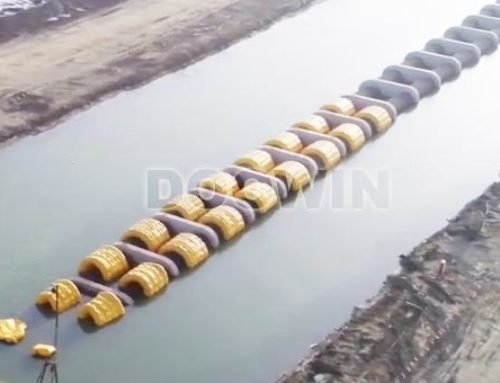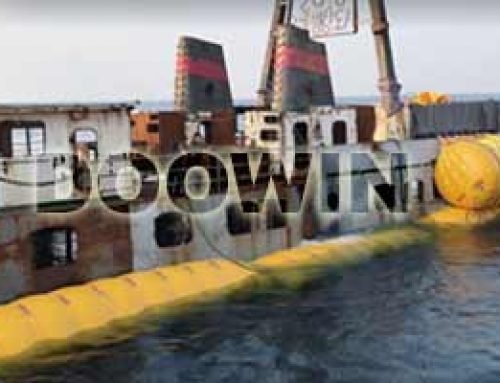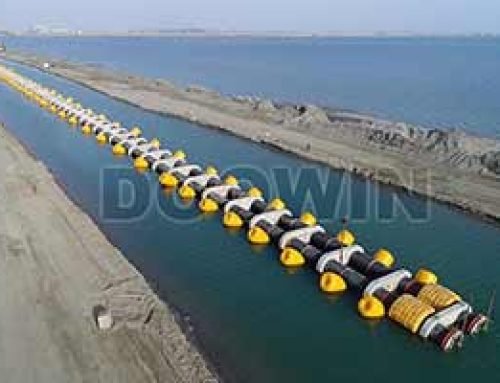Marine salvage bags are the basic flotation tools used in marine salvage project. Marine salvage is the process of recovering a ship and its cargo after a shipwreck or other maritime casualty. Salvage may encompass towing, re-floating a vessel, or effecting repairs to a ship. Today, protecting the coastal environment from spillage of oil or other contaminants is a high priority. Nowadays, most salvage is carried out by specialist salvage firms with dedicated crew and equipment.
Raising Submerged Vessels
To raise a sunken vessel the salvor must overcome its negative buoyancy. This is accomplished by using one of the five basic methods listed below
- Pumping (dewatering)
- Raising with flotation
- Raising with internal air
- Towing the vessel to the surface
- Lifting the vessel
Each method has its advantages and disadvantages, and at times it is practical to use more than one in the given situation.
In this article, we glad to introduce top 5 commonly used marine salvage bags to raise the submerged vessels as flotation bags.
- Totally Enclosed Marine Salvage Airbags
- Marine Salvage Rubber Airbags
- Pillow Flotation Lift Bags
- Steel Salvage Pontoon
- Parachute Underwater Lift Bags
Marine salvage lift bags are one kind of professional floating buoyancy units for the vessel salvages and rescue. The main application is in shipwreck salvage, floating bridge and dock construction, rescue and removal of wrecked ships and beached vessels. Customers also can use it as pontoons for supporting docks and other floating structures. These flotation bags are also excellent for underwater construction projects.
1. Totally Enclosed Marine Salvage Airbags
Totally enclosed lifting bags are cylindrical shape design. It is known as enclosed air lift bags, inflatable buoyancy units, or salvage pontoon. Enclosed lifting bags are designed to support loads on or near the surface and so are not “underwater air lift bags”.
This air lifting bags can be used at submerged vessels both sides after connecting by the passed under slings. After filling air using the compressor, its buoyancy can raise the submerged vessel up to surface.
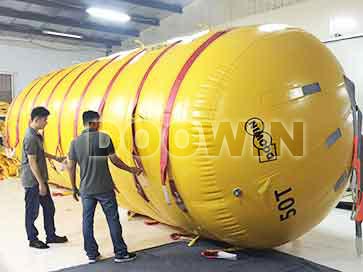
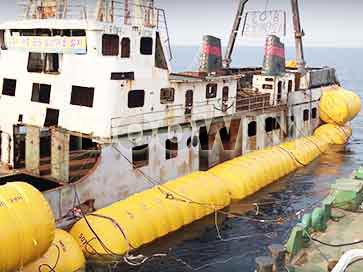
1.1 Relative merits of enclosed marine salvage airbags
Normally, the manufacturer makes totally enclosed lift bags using PVC coating fabric. This marine salvage airbags are very small in size when deflated, and are lightweight. Thus, can transport and deploy it easily. When the boat is near the surface. The salvors can sling the airbags under the boat with one end on each side to raise the boat high enough out of the water to pump it out. In shallow water, the users can sling two lift bags together like pontoons, one on each side of the boat.
Enclosed airlift bag have enough auto air pressure release valves. It will open when the inner pressure reaches the rated value. Besides, it has more advantages.
- Lightweight easy to operate
- Save storage and transportation cost
- Can be reinforced meet the heavy-duty request
- Easy to install
- Pipeline buoyancy supports
- Bigger buoyancy compare with rubber airbags
- Without rubber airbags cone ends
Comparing with the marine rubber airbags and steel pontoon, its outstanding disadvantages is easy to damage. Because the material is very thin. So sometimes, the maker reinforces it with the extra cover or spray the PU skin.
1.2 Application of totally enclosed lifting bags
The salvors can use totally enclosed lifting bags for marine salvage and re-floatation operation. Furthermore, salvor also can make it as buoyancy support pontoons for bridges, floating platforms, dock gates, sunken objects or military equipment.
Totally enclosed air lift bags offer an effectual floatation method. To reducing the draught of the vessel and lift bag salvage underwater structures. Likewise, these marine airbags also are ideal buoyancy modules for cable or pipeline laying and boat lift air bags.
2. Marine Salvage Rubber Airbags
Marine salvage rubber airbags are evolved from ship launching rubber airbags. All manufacturer produce the rubber marine salvage airbags using heavy-duty synthetic-tire-cord layers with inner and out rubber layers in a long cylindrical balloon shape. In the beginning, people used these rubber airbags to launch a ship or lifting heavy objects. And, then people started to equip the lifting belts with rubber airbags as marine salvage airbags.
The rubber marine salvage airbags are cylindrical balloon body with two conical head. There are air tightness swivels and air inlets at end mouth. Polyester webbing lifting straps are around the whole marine rubber airbags.
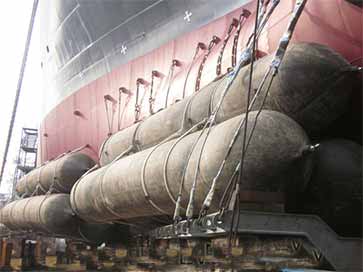
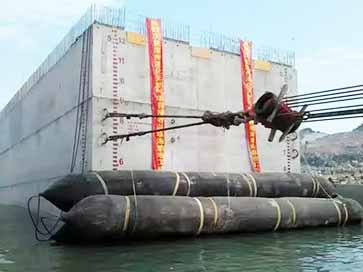
2.1 Relative merits of marine salvage airbags
Its material is synthetic-tire-cord layers that covered with high tensile rubber layers. Its thickness is up to 12mm or more. So it can resistant the scratch and abrasion under severe environment. It is the most outstanding advantages than the PVC made marine salvage airbags.
But these marine salvage airbags are too heavy. Per square material is about 1.8kg. For example, one 1.5m diameter x 10m length 6 layers rubber airbags. Its buoyancy capacity is about 17ton. But its weight reaches 400kg. Per 17ton enclosed lifting bags is only about 120kg. So, its outstanding disadvantage is too heavy. Not suitable for the small vessel salvage.
2.2 Application of rubber marine salvage airbags
Marine rubber salvage airbags are the system of choice where reliable, controllable buoyancy is required. They are particularly suited for installation buoyancy on pipeline float-out, beach pulls and river crossings. We can use the marine rubber airbags in applications such as vessel and platform draught reduction in limited water depths. And, some users also use it as salvage pontoons for temporary bridges and docks. In addition, also can it for salvage the shipwreck, rescue the floating bridge and dock construction using these airbags.
When rubber marine salvage airbags employed in heavy-duty salvage work under severe environment. It comes into its own.
3. Pillow Flotation Lift Bags
Enclosed pillow lift bags are one kind of versatile enclosed flotation bags. Pillow lift bags are better for the light underwater salvage more than any other style air lift bags. The most versatile floatation bags for salvage towing, shallow water, and rigging.
The pillow type enclosed flotation bag is the most versatile lift bags when shallow water or towing is a concern. The customer can use the pillow lift bags in an upright or flat position. And, also can use it inside vessels under the decking. Perfect for vessel salvage, automobile recovery, underwater construction, logging, dock support during flotation repair, and plane recovery.
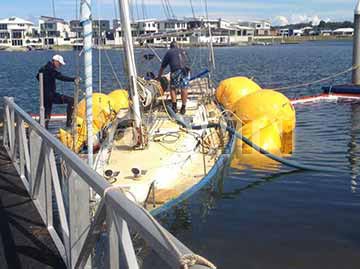
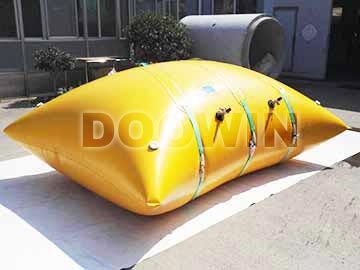
3.1 Relative merits of pillow lift bags
Pillow lift bags are made of high-strength PVC coating fabric, which is highly abrasion, and UV resistant. Each pillow type enclosed flotation bags consist of heavy duty webbing harness with single pick points and screw pin shackle, 3/4” stainless steel ball valves and quick connectors. Pillow flotation lift bags can reach the largest lift in shallow water. The pressure relief valves can open when the pressure reaches about 2.5psi.
Because of its material is PVC coating fabric too. So it is not comparable with the marine rubber airbags. Besides, its largest lift capacity is only 5ton. It is not good for the big vessel raising.
3.2 Application of enclosed flotation bags
When you need to float an object close to the surface, pillow-shaped enclosed flotation bags are the best choice. The salvors can use it in any position—upright or flat, outside or inside of structures – for vessel salvage, auto recovery, pipeline, and cable installation and emergency flotation for ships, plane, submersibles, and ROVs.
In the case of most small vessels, the salvor can use compressed air to fill pillow lift bags until enough flotation is proved to overcome the negative buoyancy of the vessels. It also can be stowed inside the vessel provide lift.
4. Steel Salvage Pontoon
The salvor can weld the steel pontoon or use 55-gallon oil drums to raising submerged vessels. The salvage steel pontoon is a kind of container for generating water buoyancy. It is sealed around, immersed in water can generate huge buoyancy.
The customized steel salvage pontoon consists of three buoyancy chambers and an air chamber. There also are systems for intake and exhaust, water intake and drainage, and cable lashing.

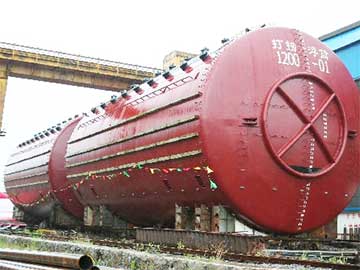
4.1 Relative merits of steel pontoon
When sunk the steel pontoon to subsea (not too deep), the water pressure cannot compress it because of its hard steel material. So there is no buoyancy loss. But the user cannot fold the steel pontoon too like underwater lift bags or rubber airbags. So, it needs a large space for storage. And its transportation cost is very high too.
Besides, its buoyancy is fixed. The salvors cannot adjust it according to the site request. But its buoyancy is huge compared with other marine salvage airbags.
4.2 Application of steel salvage pontoon
The steel salvage pontoons are very suitable for the huge big vessel salvage work. And it is workable for any water depth too.
The steel pontoon can provide controlled buoyancy for submerged vessels. And it is a rapid treatment of the port area, navigation channel, sudden and catastrophic at sea. It is one of the important equipment for emergency rescue of incidents is used to salvage sunken ships and sunken objects. Some people also use it to assist in stranding, retreating from reefing ships, and maintaining the buoyancy and stability of damaged ships.
5. Parachute type Underwater Lift Bags
Parachute type underwater air lift bags are one kind of professional marine salvage airbags and diving work air lifting bags. It is water drop shaped units. There are open or enclosed bottom parachute type designs. These air lifting bags include commercial diving lift bags and professional lift bags.
Underwater air lift bags are not just a handy tool, but also a major piece of lifting equipment and should be treated as such. They differ from conventional lifting equipment in that the loading comes from the upthrust generated by the volume of water displaced when the bags are filled with air. Lift bags should always be used in conjunction with a suitable lift plan and risk assessment.
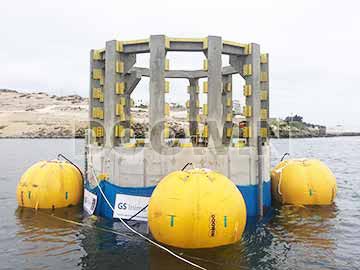
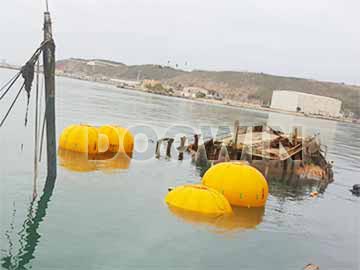
5.1 Relative merits of parachute-type lift bags
Open parachute underwater air lift bags have the open bottom design. So can use it for any water depth operation. Can use it to lift objects or sunk vessels from any water depth. It is more safety.
The material of air lift bags is PVC coating fabric. So it is lightweight easy to operate. Meanwhile, it only has one lifting point. So it is easy to install. And it has vast working agree. Don’t like the enclosed cylindrical airbags have to use horizontally.
5.2 Application of parachute underwater lift bags
Generally, the salvors can use open bottom air lifting bags at any depth for marine salvage or re-floatation objects from the seabed. Because the open bottom design makes the operation more safety. Thus, this parachute lift bags is one kind of all-purpose inflatable buoyancy units. Especially, can use it for the scuba diving lift bags, marine salvage bags, boat lift salvage, shipwreck salvage, and float bags salvage.
Herein, we list some common application.
- Deepwater salvage
- Ship salvage buoyancy support
- Shipwreck salvage
- Static buoyancy support
- Commercial and military use
- Subsea rigging
- Military equipment lifting
- Floating bridge supports
- Inflatable pontoons
- Extra buoyancy for pipe and cable
Also, and raising work, the parachute underwater airbag lifts have two general types – static and dynamic:
- Static lift – this is where an air lift bag is secured by hold-back rigging and used as a single lift point, commonly known as a “skyhook”. The air lift bag has very positive buoyancy. But it is directly restrained to anchor points. Thus, the lift bag is fixed and the load is free to move vertically with the use of a suitably approved lifting device;
- Dynamic lift – this is where the air lift bag is used to lift the load directly, typically for the movement of loads between locations. The parachute lift bag and the load tend to be close to neutrally buoyant with a system of restraints in place. In such instances, the lift bag and load should move together.
You can refer IMCA D 016 – Rev.4 “Guidance On Open Parachute Type Underwater Air Lift Bags” to know more information. Or see our other related articles.
In one word, every kind marine salvage airbags have its special own application. According to the project condition, the salvor should choose suitable marine salve bags.

